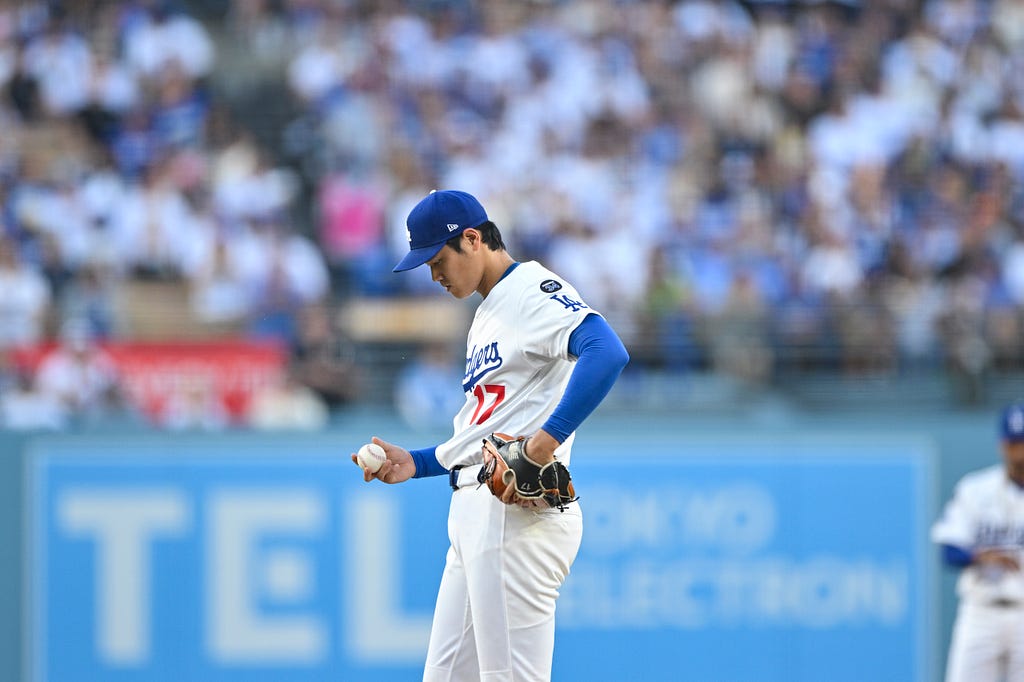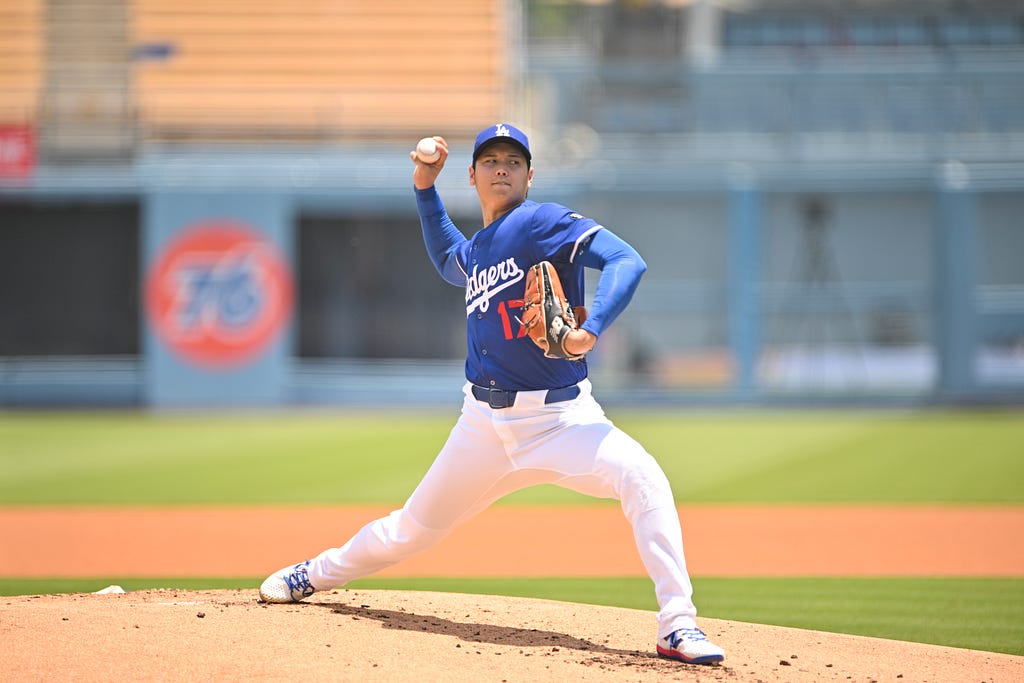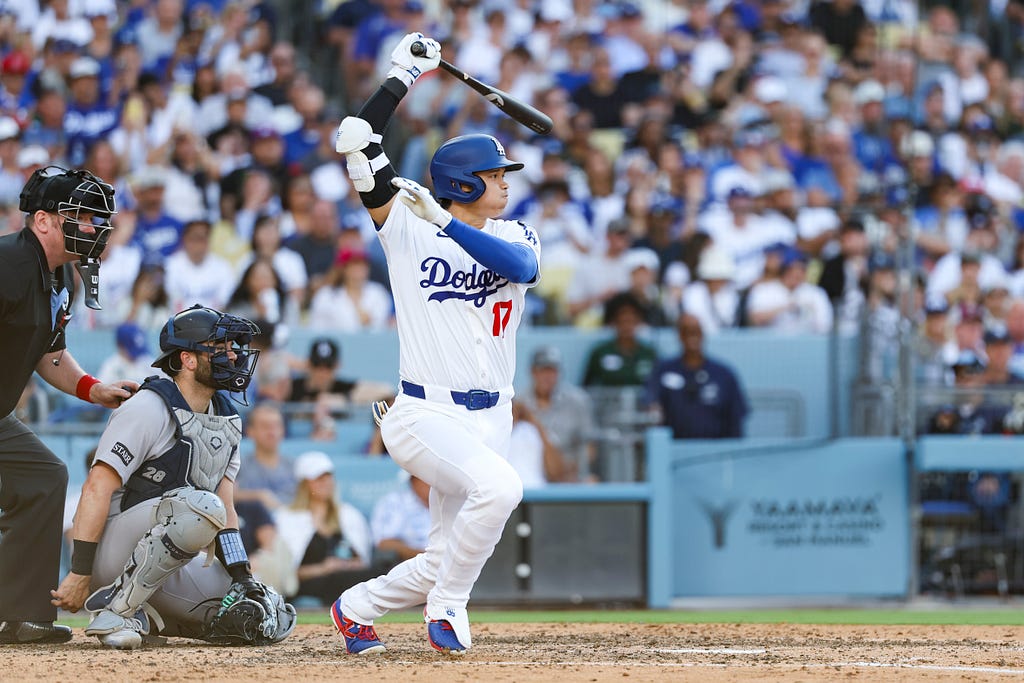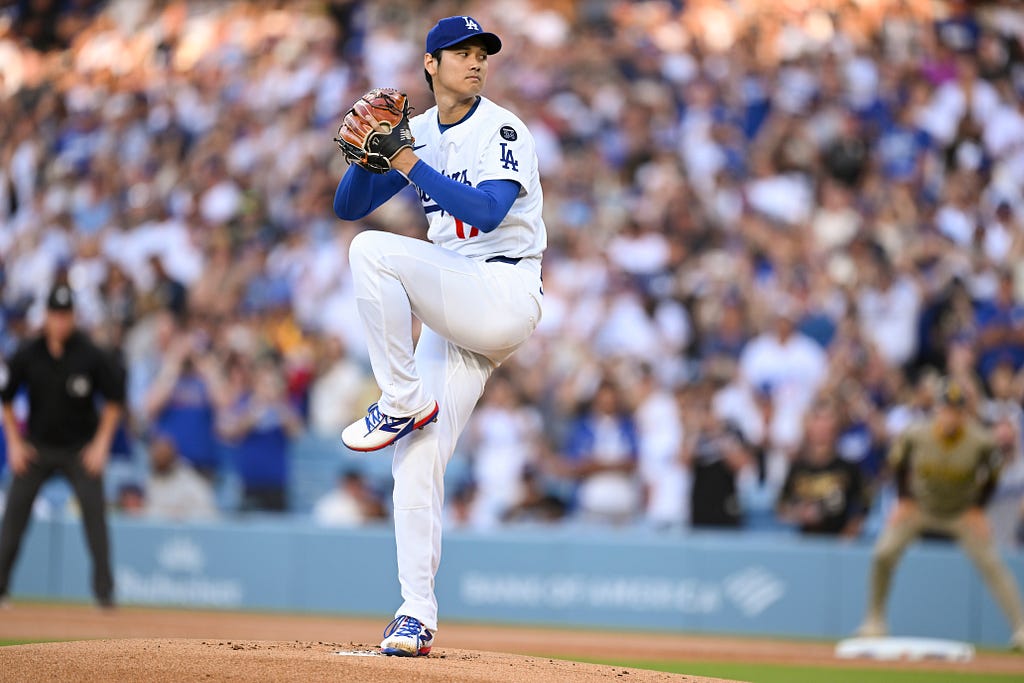From Dodger Insider magazine: Shohei Ohtani — All things remarkable
Shohei Ohtani’s return to the mound completes one of his important missions as a Dodger

Editor’s note: This story is taken from the pages of Dodger Insider magazine.
by Cary Osborne
After the 28th and final pitch of Shohei Ohtani’s pitching debut for the Dodgers on June 16, the incomparable baseball player walked with purpose to the ledge of the camera well adjacent to his team’s dugout.
His bat, shin guard, elbow guard, batting gloves and hand protector all waited for him as he made the transition from pitcher to hitter in a flash.
He turned away a cup of water, but accepted a towel to wipe the sweat from his forehead and dark hair.
This wasn’t like Clark Kent changing into his Superman outfit. It was like Superman changing into his Batman outfit.
This was also the picture that the Dodgers — that includes the front office, coaching staff, teammates and fanbase — had waited to see since he signed on Dec. 11, 2023.
The actual visual of the incredible two-way sensation in action.
June 16, 2025 was a long time coming.
The Dodgers signed Ohtani, coming off a second elbow surgery, with the intent of him returning as a pitcher at some point. The intent was never for him to remain just a designated hitter.
He was a two-way player in his first professional season with the Nippon Ham Fighters of the Nippon Professional Baseball league in 2013. One major reason that the Dodgers lost out on him when he decided to come to the Major Leagues before the 2018 season was the designated hitter didn’t exist in the National League then. He was clear that he wanted to impact both sides as a starting pitcher and then as a DH on days he wasn’t pitching. The Angels won his services, and by 2022 he had ascended to his Major League pitching peak — finishing second in the American League Cy Young Award balloting.
But after exiting in the second inning on Aug. 23, 2023, due to elbow fatigue, he would go on to have a second elbow surgery.
The Dodgers were consistent in their wording after he signed — he was going to resume pitching at some point.
And Ohtani was consistent in his desire to pitch for the Dodgers.

Last August, in the midst of one of the greatest offensive seasons in Major League history, Ohtani made an admission.
“Yeah, I do miss pitching,” he said.
His team could see it.
“He was on the 50/50 hunt last year. He’d be in the locker room pitching dry reps,” says Dodger reliever Evan Phillips. “I’m like, ‘This guy’s an MVP and still worried about his delivery?’”
“He loves it, absolutely loves it,” says Dodger assistant pitching coach Connor McGuiness. “He’s the epitome of a baseball junkie. He loves all aspects of it. He studies his butt off. He’s analyzing opposing pitchers. He’s analyzing how even our guys are getting the opponents out. He’s not taking a pitch off. He’s watching the whole game. This guy’s just obsessed with baseball, and he just so happens to be the best ever at it.”
One night after Ohtani became the sixth player in Major League history to reach 40 home runs and 40 stolen bases in a season (with a walk-off grand slam, no less), he threw his first post-surgery bullpen on Aug. 24.
And he continued to throw.
It prompted this question to manager Dave Roberts before the World Series: Is there any possibility of Shohei Ohtani pitching for you in the World Series?
“There’s no possibility, none whatsoever. Thank you for asking,” Roberts said.
Yet that didn’t stop many from asking: “Yeah, but what if?”
That question didn’t require another answer. The Dodgers didn’t need to rush him along. A torn labrum in his left non-throwing shoulder, suffered in Game 2 of the World Series, further drove home the impossibility.
But on Feb. 15, Ohtani threw his first bullpen at Spring Training at Camelback Ranch. Fans stood watching, rows deep, behind a chain-link fence.
“No,” Roberts answered on whether he had ever seen this kind of attention for a first Spring Training bullpen. “There’s a lot of things since we signed Shohei that I haven’t seen around a baseball field.”
Bullpens continued in March, April and May.
There was internal, though tempered, excitement about the possibilities for a return. Much of that was caused by what people were seeing in those sessions.
McGuiness says there was something that stood out about Ohtani when he would throw off flat ground or a mound. The right-hander creates an incredible amount of ground force that leads to more power on each pitch.
“He uses the ground better than any pitcher I’ve ever watched,” McGuiness says. “Just the divots he creates on the push off, even the landing, just the amount of energy he’s actually sending up through his chain is unheard of for me. And having been here now for a number of years, we’ve had a handful of really incredible pitchers — Hall of Famers — and I’ve never seen anyone use the ground the way he does.”
Ohtani threw his first simulated inning on May 25 at Citi Field in New York. And he threw his first at Dodger Stadium on May 31. Rookie catcher Dalton Rushing faced him in the batter’s box on May 25 and caught him six days later.
“His stuff’s electric,” Rushing says. “From a catching perspective. It takes a little more emphasis with everything that he throws.
“The splitter’s pretty legit. It’s a unicorn pitch. But it’s really more than just that. He’s got multiple pitches that are just outliers compared to other pitchers. Obviously, that’s what makes him the player that he is, and the unicorn on the mound.”
He is the unicorn on the mound, in the batter’s box and all paths toward each.
Those who surround him gush about his rare skillset and extraordinary accomplishments, but they also rave about what it takes for him pull off being elite at both.

“It takes a special brain, work ethic and self-belief to overcome the challenges he faces and thrive,” Roberts says. “He is just really built different than anyone I’ve ever seen. Pitching and hitting in the Major Leagues separately is very difficult. But then to do that together, combined with coming off a major surgery, I marvel at him. But he’s a very disciplined player.”
Roberts often goes back to the word “compartmentalization” when it comes to Ohtani, and that it’s another area where he is heads above most — not just baseball players — but athletes.
Everything — the desire to pitch and hit, the work, the compartmentalization — all came together on June 16.
Hours before he took the mound, there was a buzz in the stadium. The epicenter was the Dodger clubhouse, as teammates talked about what they were about to witness.
“How hard do you think his first pitch is going to be?” reliever Alex Vesia asked. “Because he’s been 95, 97 (mph) in his live (sessions)? Is it going to be 99? Is he going to go one inning or is he going to go two innings?”
The answer to the first question was 97.6 mph to San Diego’s Fernando Tatis Jr. Nine pitches later, Ohtani dialed it up to 100.2 mph.
“I was aiming to sit 95–96 but the game intensity really allowed me to throw a little harder,” Ohtani said after the game.

The answer to the second question was one inning. Ohtani allowed two singles and a run. He threw 28 pitches, but he garnered praise for his command and poise despite the stress.
“Seeing him come off the mound and not even go into the dugout, I don’t know, it just it kind of hit a little different seeing it from our side now,” said Dodger third baseman Max Muncy. “That’s incredible what he’s able to do.”
Then he did that other thing that he does. He doubled in the Dodgers’ first run in the third inning. He added an RBI single in the fourth inning.
“I’m just really grateful reflecting back on all the support that I received from the doctor who operated on me, the support staff on the team, and everybody who supported me along the way,” Ohtani said. “So I’m just grateful that, aside from the results, to be able to show. (I’m) grateful for the moment that I had today.”
From Dodger Insider magazine: Shohei Ohtani — All things remarkable was originally published in Dodger Insider on Medium, where people are continuing the conversation by highlighting and responding to this story.